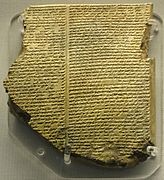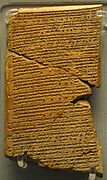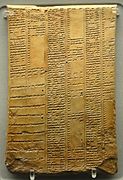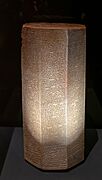Library of Ashurbanipal facts for kids
Quick facts for kids Library of Ashurbanipal |
|
|---|---|
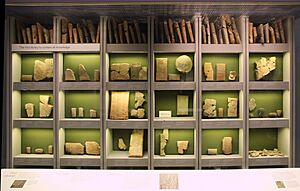 |
|
| The Library of Ashurbanipal in the British Museum | |
| Established | 7th century BCE |
| Location | Nineveh, capital of Assyria |
| Collection | |
| Size | over 30,000 cuneiform tablets |
The Royal Library of Ashurbanipal was a huge collection of ancient writings. It was named after Ashurbanipal, who was the last powerful king of the Assyrian Empire. This library held over 30,000 clay tablets and pieces of writing. These texts were from the 7th century BCE and covered many different topics and languages. One very famous story found here was the Epic of Gilgamesh.
This amazing library helps modern historians learn a lot about people from the ancient Near East. A famous historian, H. G. Wells, even called it "the most precious source of historical material in the world."
The library's materials were discovered at an archaeological site called Kouyunjik. This was once the ancient city of Nineveh, the capital of Assyria. Today, this site is in northern Iraq, near the city of Mosul.
Contents
How the Library Was Found
The discovery of this library is mostly thanks to Austen Henry Layard. Most of the clay tablets found were sent to England. You can see them now at the British Museum. The first discovery happened in late 1849. It was in a building known as the South-West Palace. This was the royal home of King Sennacherib (who ruled from 705 to 681 BCE).
Three years later, Hormuzd Rassam, who worked with Layard, found another similar library. This one was in the palace of King Ashurbanipal (who ruled from 668 to 627 BCE). It was on the other side of the ancient mound. Sadly, no detailed notes were made about where each tablet was found. Because of this, when the tablets arrived in Europe, they got mixed up. It's now very hard to figure out exactly what was in each of the two main libraries originally.
What Was Inside the Library?
King Ashurbanipal was known as a strong military leader. But he was also a very smart person who could read and write. He loved collecting books and tablets. To build his library, he sent messages to cities and learning centers all over Mesopotamia. He told them to send him copies of all the writings from their regions.
As a young student, Ashurbanipal learned to read and write both the Akkadian and Sumerian languages. He sent scribes, who were like professional writers, across the entire Neo-Assyrian Empire. Their job was to collect old texts. He also hired scholars and scribes to copy texts, especially from Babylonia.
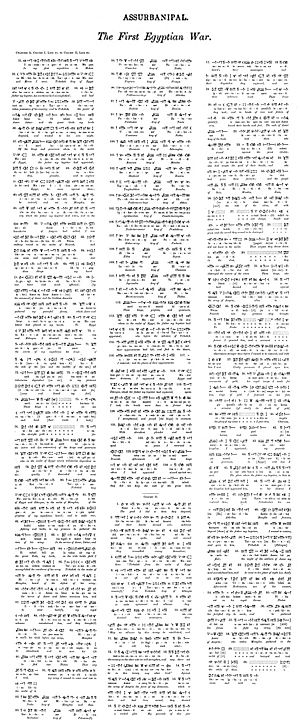
Ashurbanipal also used items taken during wars to fill his library. He was known for being very tough on his enemies. This meant he could use threats to get writings from Babylonia and nearby areas. He was especially interested in collecting texts about predicting the future. This was a big reason why he gathered so many works for his library. He might have wanted to "get hold of special rituals and magic spells that were important for keeping his royal power."
The royal library had about 30,000 tablets and writing boards. Many of these were broken into small pieces. A lot of the tablets had a stamp showing they belonged to his palace. Experts believe that around 2,000 tablets and 300 writing boards were in the library when it was destroyed. Most of the tablets (about 6,000) were everyday writings. These included laws, letters with other countries, royal announcements, and money matters.
The other texts included predictions, omens, magic spells, and songs to different gods. Some were about medicine, astronomy, and literature. Only about ten of all these texts were expressive stories like epics and myths.
The famous Epic of Gilgamesh was found in this library. Also found were the Enûma Eliš creation story, the myth of Adapa (the first man), and stories like the Poor Man of Nippur.
Another type of text found was lists of words and signs. There were many pieces of tablets with old cuneiform signs. Assyrian scribes needed these lists to read ancient writings. Most of these lists were made by Babylonian scribes. Other Babylonian texts found were epics, myths, and historical records. There is only one math text that is believed to have been found at Nineveh.
Most of the texts were written in the Akkadian language using cuneiform script. However, it's often hard to know where many of the tablets originally came from. Many tablets were written in the Neo-Babylonian style. But many were also known to be written in the Assyrian style.
The tablets were often organized by their shape. Four-sided tablets were used for money deals. Round tablets recorded information about farming. In this time, some documents were also written on wood or wax tablets. Tablets were sorted by what they were about and put in different rooms. For example, there were rooms for government, history, law, and astronomy. The contents were marked with colors or short descriptions. Sometimes, they were identified by the "incipit," which means the first few words of the text.
Nineveh was destroyed in 612 BCE by a group of Babylonians, Scythians, and Medes. It is thought that a huge fire burned the palace when it was destroyed. This fire partly baked the clay cuneiform tablets. This event, which seemed destructive, actually helped to preserve the tablets. Besides clay tablets, some texts might have been written on wax boards. These wax boards have been lost because they were made of organic material.
The British Museum has about 30,943 "tablets" from the Nineveh library. The museum plans to create an updated list of them. If all the small pieces that belong to the same text are counted as one, the library likely had about 10,000 texts in total. However, the original library documents would have included leather scrolls and wax boards. These might have held even more knowledge than what we know from the surviving clay tablets. A large part of Ashurbanipal's libraries was made up of writing-boards, not just clay tablets.
The Ashurbanipal Library Project
Since 2002, the British Museum has been working on a project to list all the items from Ashurbanipal's library. This project is done with the University of Mosul. The main goal is to record the library in as much detail as possible. This includes texts, images, translations, and high-quality digital pictures.
The project has been carried out in different stages. Results were published in 2003, 2004, and 2014. During the last stage, high-quality digital images of all the library tablets were made. Each image is created using 14 different pictures. This allows for a virtual 2D view of the 3D tablets. These images are now available online for everyone to see.
As of 2020, the project is working on two main things. First, they are trying to put together medical texts from the cataloged tablets. Second, they are using notes scribes wrote at the bottom of each tablet. This helps them understand how big the tablet collection was. The list of tablets is still being updated. Many other projects and experts have helped by sharing their materials.
Important Tablets and Cylinders
- Azekah Inscription
- Esarhaddon's Treaty with Ba'al of Tyre
- Nimrud Tablet K.3751
- Sargon II's Prism A
- Venus tablet of Ammisaduqa
- Epic of Gilgamesh
- Enûma Eliš
- Rassam cylinder
- K.3364
- Tablets and cylinders from the Royal Library
-
The ""Venus Tablet of Ammisaduqa"" shows predictions based on the planet Venus.
-
The Rassam cylinder of Ashurbanipal has ten sides. It's at the British Museum.
-
This is the Prism of Sennacherib. It tells about his military campaigns, including when he destroyed Babylon.
See also


